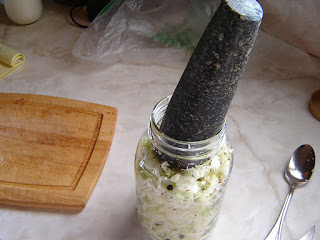These days it almost seems as though I'm either posting about pumpkins, or something to do with kefir. So, no exception here. When you're thrilled about a subject what can you do but share the fun with the world at large. I do realize that for some of you this is nothing new, still ...
When you have kefir in the fridge, a culture in process on your counter top, and some cream cheese draining right next to it, you have arrived in kefirland. Also there's a lot going on in your kitchen. Now with whey to utilize from the cheese, you can imagine my delight at discovering a recipe for making pickled veggies of various sorts, including sauerkraut. Kefir whey shortens the fermentation period, so that hardly any salt is needed. Though after fermenting at room temperature for 3 to 4 days, you do want to let it mature in the fridge. Don't do as we did, eating it before the 2 to 3 recommended weeks were up. Now it's almost all gone, just when the flavor's getting to the fabulous stage. Please see if you can restrain yourselves.
Sauerkraut, or Kim Chee have been used for centuries, valued for their many health benefits, aside from the delicious factor. For more information, here is a good reference. Of interest to us in Hawaii, Captain James Cook carried sauerkraut on his ships to prevent scurvy. Yes, vitamins are retained, and cabbage is high in vitamins A and C. In addition, if you tend to have sugar cravings, fermented and pickled foods will help with that. Traditional Chinese medicine recommends bitter foods, such as arugula, radicchio, endive or chicory. Lactic-acid, generated by lactic-acid bacteria during fermentation, also creates a “bitter” flavor in the form of peptides.
Without further ado, here is the recipe I just used to rather yummy effect. And, you should know it is soooo easy to make, no more trouble than your ordinary salad. All it needs is some time sitting around.
Whey Easy Sauerkraut
1 head cabbage, shredded finely (you can use a food processor)
1/2 teaspoon mustard seeds
1/2 teaspoon cumin seeds
1 teaspoon juniper berries
1 teaspoon peppercorns
1 cup water mixed with 2 tablespoons kefir whey (or yogurt whey) and
2 teaspoons sea salt
In a large bowl lightly mix the ingredients together, excluding water mixture. Mash/pound cabbage with pestle or your fist for a few minutes, to release the juices.
Now cram/press the seasoned cabbage into a large Mason jar, or similar. You may even need an extra jar. Pound it down good. Stir the salt and whey into the water. When salt is dissolved, add liquids to the cabbage in jar. It needs to come to an inch below the top and about an inch above the cabbage, so add more water if necessary. Make sure the cabbage is below the liquid, weighting it down if needed. Screw on a plastic lid and leave at room temperature 3 to 4 days. Loosen the lid from time to time, allowing the bubbling gas to escape. Now refrigerate at least 2 weeks before using. Longer is better. Think fine wines.
I do love this stuff. Will be sending it over to Week-end Herb Blogging, hosted this week by Cristina of La Cucina di Cristina. Next I'm going to try the whey innoculated version of Kim Chee (Whey Easy Kim Chee). Will keep you all posted.






5 comments:
I've actually never had kefir but I know it's something I really shoudl try! What a crazy take on sauerkraut!
I love sauerkraut so I just have to try this!!!
Thanks for sharing this recipe with the WHB.
Baciusss
Very interesting, Claudia. I must tell you that after reading your first post on kefir, I decided to make it. However, I got culture, not the grains. Things went in a rather different direction from what I had envisioned, but good overall. I need to make it again and then take photos before I can share the experience on my blog. I love the idea of having things going and using one thing of this to do that.
Simona, the grains are the culture. I use the terms interchangeably. I too got a live culture from someone with excess. You can buy dry culture grains at natural food markets, but I haven't had experience with reconstituting that sort.
Our exchange here is history, so to say. I have not tried to make sauerkraut yet, but I have used some of they whey to acidify whey from making cheese as part of the ricotta-making process I follow.
Post a Comment